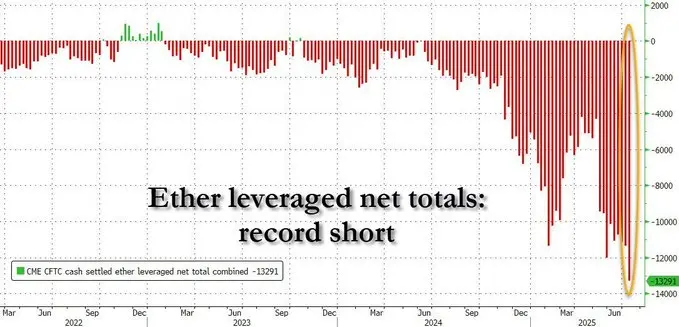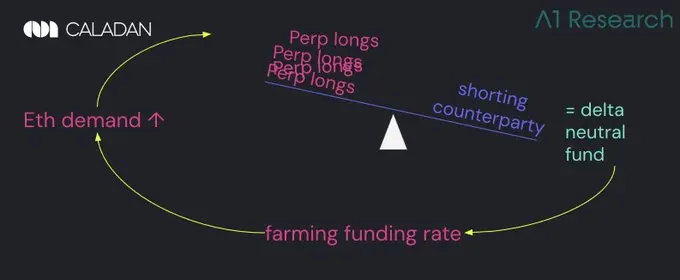Author: A1 Research
Translation: Tim, PANews
Ethereum's price fluctuations seem simple: retail enthusiasm rises, prices soar, and market optimism continues to ferment. But beneath the surface lies a structurally complex market mechanism. The funding rate market, the hedging operations of neutral strategy institutions, and recursive leveraged demand intertwine, exposing deep systemic vulnerabilities in the current crypto market.
We are witnessing a rare phenomenon: leverage has essentially become liquidity itself. The massive long positions taken by retail investors are fundamentally reshaping the risk of neutral capital allocation, giving rise to new market vulnerabilities that most market participants have yet to fully recognize.
1. Retail trend-following long phenomenon: when market behavior is highly synchronized
Retail demand is concentrated in Ethereum perpetual contracts because these leveraged products are easily accessible. Traders rush into leveraged long positions at a rate far exceeding the actual demand for spot ETH. The number of people betting on ETH's rise far exceeds those actually purchasing Ethereum spot.
These positions require counterparties to take them on. However, as buying demand becomes excessively aggressive, short orders are increasingly absorbed by institutional players executing delta neutral strategies. These are not directional bears, but funding rate harvesters; they are not shorting ETH but are seeking to arbitrage structural imbalances.
In fact, this practice is not traditional short selling. These traders short perpetual contracts while holding equivalent spot or futures long positions. As a result, they do not bear ETH price risk, but they earn profits through the funding rate premium paid by retail longs to maintain leveraged positions.
With the evolution of the Ethereum ETF structure, this arbitrage trading may soon be enhanced by overlaying passive yield layers (staking yields embedded in ETF packaging), further strengthening the appeal of delta neutral strategies.
This is indeed a brilliant trade, provided you can tolerate its complexity.

Delta neutral hedging strategy: a legitimate 'money printing' response mechanism
Traders short ETH perpetual contracts to take on retail long demand while hedging with spot long positions, thereby converting structural imbalances caused by persistent funding rate demand into profits.
In a bull market, the funding rate turns positive, requiring longs to pay fees to shorts. Institutions adopting neutral strategies, while hedging risks, earn profits by providing liquidity, thus forming profitable arbitrage operations that attract continuous inflows of institutional capital.
However, this gives rise to a dangerous illusion: the market appears deep enough and stable, but this "liquidity" depends on a favorable funding environment.
The moment the incentive mechanism disappears, the structure it supports will also collapse. The apparent market depth will instantly turn void, and with the sudden collapse of the market framework, prices may experience violent fluctuations.
This dynamic is not limited to crypto-native platforms. Even at the institution-dominated Chicago Mercantile Exchange, most short liquidity is not directional bets. Professional traders short CME futures because their investment strategies prohibit opening spot exposure.
Options market makers delta hedge through futures to enhance margin efficiency. Institutions are responsible for hedging institutional client order flow. These are structural necessary trades and do not reflect bearish expectations. The open interest may rise, but this rarely conveys market consensus.
Asymmetric risk structure: why it is actually unfair
Retail longs face the risk of liquidation directly when prices move unfavorably, while delta neutral shorts usually have stronger capital backing and are managed by professional teams.
They use the ETH they hold as collateral, enabling them to short perpetual contracts under a fully hedged, capital-efficient mechanism. This structure can safely bear moderate leverage without triggering liquidations.
The two have structural differences. Institutional shorts possess lasting resilience and sophisticated risk management systems to withstand volatility, while leveraged retail longs have weak capacity and lack risk management tools, with almost zero tolerance for error.
When market conditions shift, longs can quickly collapse while shorts remain solid. This imbalance can trigger seemingly sudden but structurally inevitable liquidation waterfalls.
Recursive feedback loop: when market behavior becomes self-interfering

The demand for long positions in Ethereum perpetual contracts remains, requiring delta neutral strategy traders to act as counterparties for short hedging. This mechanism sustains the funding rate premium. Various protocols and yield products compete for these premiums, driving more capital back into this cyclical system.
An endlessly spinning money-making machine does not exist in reality.
This will continuously create upward pressure, but it entirely depends on one prerequisite: longs must be willing to bear the cost of leverage.
The funding rate mechanism has an upper limit. At most exchanges (like Binance), the maximum funding rate for perpetual contracts every 8 hours is 0.01%, equivalent to an annualized yield of about 10.5%. When this limit is reached, even if long demand continues to grow, shorts seeking yield will no longer be incentivized to open positions.
Risk accumulation reaches a critical point: arbitrage returns are fixed, but structural risks continue to grow. When this critical point arrives, the market is likely to liquidate rapidly.
Why does ETH fall harder than BTC? The dual-ecosystem narrative dispute
Bitcoin is benefiting from non-leveraged buying driven by corporate fiscal strategies, while the BTC derivatives market has stronger liquidity. Ethereum perpetual contracts are deeply integrated into yield strategies and the DeFi protocol ecosystem, with ETH collateral continuously flowing into structured products like Ethena and Pendle, providing yield returns for users participating in funding rate arbitrage.
Bitcoin is often seen as driven by natural spot demand from ETFs and corporations. However, a significant portion of ETF capital flow is actually a result of mechanical hedging: traditional finance basis traders buy ETF shares while shorting CME futures contracts to lock in a fixed price spread between spot and futures for arbitrage.
This is akin to the nature of ETH's delta neutral basis trading, only executed through regulated packaged structures and financed at a cost of 4-5% in dollars. In this sense, ETH's leveraged operations become yield infrastructure, while BTC's leverage forms structured arbitrage. Neither is directional trading; both aim to obtain profits.
Circular dependency issue: when the music stops
Here’s a question that might keep you awake at night: this dynamic mechanism has an inherent cyclical nature. The profitability of delta neutral strategies relies on a sustained positive funding rate, which requires the long-term continuation of retail demand and a bull market environment.
The funding rate premium does not exist permanently; it is very fragile. When the premium contracts, the liquidation wave will begin. If retail enthusiasm wanes and the funding rate turns negative, it means that short sellers will pay fees to long holders instead of collecting a premium.
When large amounts of capital flow in, this dynamic mechanism creates multiple vulnerabilities. First, as more capital flows into delta neutral strategies, the basis will continuously compress. Financing rates decrease, and the profits of arbitrage trades also diminish.
If demand reverses or liquidity dries up, perpetual contracts may enter a discount state, meaning the contract price is lower than the spot price. This phenomenon can hinder new Delta neutral positions from entering and may force existing institutions to close their positions. Meanwhile, leveraged longs lack margin buffer space, and even a mild market correction could trigger a chain liquidation.
When neutral traders pull back liquidity, long positions can be forcibly liquidated like a waterfall, creating a liquidity vacuum where there are no true directional buyers below the price, only structural sellers. The originally stable arbitrage ecosystem rapidly flips, evolving into a chaotic liquidation wave.
Misreading market signals: the illusion of balance
Market participants often misinterpret hedging capital flows as bearish sentiment. In fact, the high short positions in ETH often reflect profitable basis trading rather than directional expectations.
In many cases, what appears to be a strong depth in the derivatives market is actually supported by temporarily rented liquidity provided by neutral trading desks, which harvest profits from funding premiums.
While the inflow of funds into spot ETFs can generate a certain degree of natural demand, the vast majority of trades in the perpetual contract market are essentially structured artificial operations.
Ethereum's liquidity is not rooted in belief in its future; it exists as long as the funding environment is profitable. Once profits dissipate, liquidity will follow suit.
Conclusion
The market can remain active in the long term under structural liquidity support, creating a false sense of security. But when conditions reverse and longs cannot maintain their financing obligations, a collapse can occur in an instant. One side gets completely crushed, while the other exits calmly.
For market participants, identifying these patterns signifies both opportunity and risk. Institutions can profit by gaining insight into funding conditions, while retail investors should distinguish between artificial depth and real depth.
The driving force behind the Ethereum derivatives market is not a consensus on decentralized computing, but rather the structural harvesting of funding rate premiums. As long as funding rates remain positively yielding, the entire system can operate smoothly. However, when the situation reverses, people will ultimately discover that the seemingly balanced facade is merely a carefully disguised leverage game.



